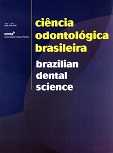Análise fotoelástica da distribuição de tensões induzidas por infra-estruturas implanto-suportadas após soldagem a laser ou retificação de cilindros
DOI:
https://doi.org/10.14295/bds.2008.v11i1.220Abstract
O assentamento passivo de próteses fixas implanto-suportadas pode ser obtido por procedimentos laboratoriais. O objetivo deste estudo foi avaliar comparativamente a formação de tensões induzidas por infra-estruturas implanto-suportadas obtidas por duas técnicas através da análise fotoelástica. Dois grupos de infra-estrututas em titânio comercialmente puro foram obtidos sobre uma matriz metálica: I) três infra-estruturas confeccionadas pela técnica da soldagem de borda de cilindros e II) três infra-estruturas fundidas em monobloco e submetidas ao sistema de retificação de cilindros. Após análise em microscopia óptica, apenas a estrutura mais bem adaptada de cada grupo foi submetida à análise de tensões, em três seqüências de aperto dos parafusos protéticos. Após, a estrutura do grupo II sofreu secção e soldagem e foi novamente submetida à análise fotoelástica. Os resultados mostraram maior magnitude de tensões com a seqüência de aperto de parafusos da esquerda para direita e vice-versa, para ambos os grupos. A estrutura do grupo I induziu menor concentração de tensões, mesmo tendo apresentado maiores valores de desadaptação (165μm) comparada ao grupo II antes (54μm) e após secção e soldagem a laser (117μm). A técnica da soldagem de borda a laser, associada à seqüência de aperto do parafuso protético do centro para as extremidades, obteve melhores resultados formação de tensões para este tipo de reabilitação.
Downloads
Downloads
Published
How to Cite
Issue
Section
License
Brazilian Dental Science uses the Creative Commons (CC-BY 4.0) license, thus preserving the integrity of articles in an open access environment. The journal allows the author to retain publishing rights without restrictions.
=================




























